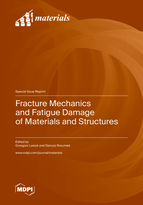Fracture Mechanics and Fatigue Damage of Materials and Structures
A special issue of Materials (ISSN 1996-1944). This special issue belongs to the section "Metals and Alloys".
Deadline for manuscript submissions: closed (20 May 2023) | Viewed by 20258
Special Issue Editors
Interests: fatigue damage; reliability analysis; fatigue crack growth theory; failure analysis of metal materials; micromechanics of materials; multiscale materials modeling
Special Issues, Collections and Topics in MDPI journals
Interests: fracture mechanics; fatigue; failure analysis; metallography; welding; fatigue crack growth; fatigue life
Special Issues, Collections and Topics in MDPI journals
Special Issue Information
Dear Colleagues,
One of the most important aspects of engineering assessment of the technical condition of structures and materials is the ability to assess the fatigue behavior of materials and structures. On the other hand, an important topic is the design of a material or structures to resist fatigue and fracture. Modern science provides us with an increasing amount of new materials, from superalloys of metals manufactured conventionally as well as by additive manufacturing to functionally advanced composites. Against this background, the fundamental knowledge of the fatigue behavior and fracture mechanics of different material groups provides a convenient platform for communication between different interested groups and fields: from material scientists, numerical engineers and mathematical modeling to hybrid methods for fatigue life prediction. This Special Issue provides such an exchange of ideas on recent developments in the field of fatigue and fracture and is especially focused on: fatigue crack growth analysis, description of fatigue damage in metals and composites, probabilistic approaches and fracture mechanics analysis as well as fatigue failure analysis and lifetime prediction.
Dr. Grzegorz Lesiuk
Prof. Dr. Dariusz Rozumek
Guest Editors
Manuscript Submission Information
Manuscripts should be submitted online at www.mdpi.com by registering and logging in to this website. Once you are registered, click here to go to the submission form. Manuscripts can be submitted until the deadline. All submissions that pass pre-check are peer-reviewed. Accepted papers will be published continuously in the journal (as soon as accepted) and will be listed together on the special issue website. Research articles, review articles as well as short communications are invited. For planned papers, a title and short abstract (about 100 words) can be sent to the Editorial Office for announcement on this website.
Submitted manuscripts should not have been published previously, nor be under consideration for publication elsewhere (except conference proceedings papers). All manuscripts are thoroughly refereed through a single-blind peer-review process. A guide for authors and other relevant information for submission of manuscripts is available on the Instructions for Authors page. Materials is an international peer-reviewed open access semimonthly journal published by MDPI.
Please visit the Instructions for Authors page before submitting a manuscript. The Article Processing Charge (APC) for publication in this open access journal is 2600 CHF (Swiss Francs). Submitted papers should be well formatted and use good English. Authors may use MDPI's English editing service prior to publication or during author revisions.
Keywords
- fatigue crack
- fatigue
- fracture mechanics
- failure analysis
- damage modeling
- FEM analysis of cracks
- defects
- metals
- composites








